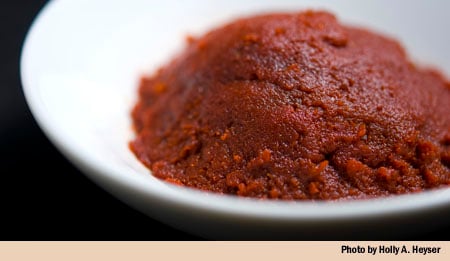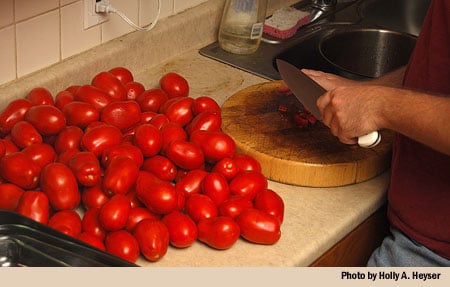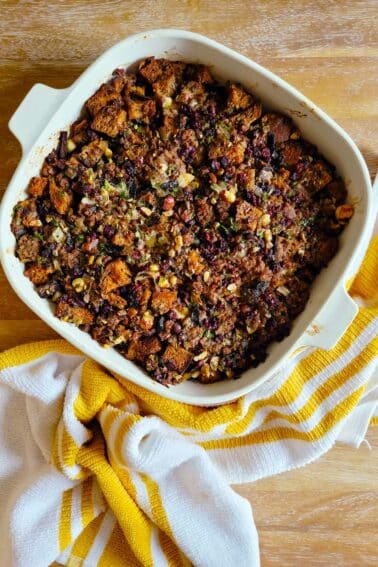As an Amazon Associate I earn from qualifying purchases.

Life, cooking — really everything — is a series of choices made and paths left unwalked, but the thought of those alternate lives or experiences never hangs lower to my consciousness than in fall. I am beginning to reach the age when the glow of living a life where All Things Are Possible starts to fade. Fall reminds me of this far more than winter. Winter for me is a season of survival. Get through it. Take stock of what you have. Make hopeful plans for the future. Fall is when the reckoning comes for those winter-made plans.
What does all this have to do with a simple tomato paste? Everything, really.
Call it tomato conserva, estratto, estrattu, ‘strattu or just tomato paste, this simple ingredient anchors my cooking all winter long. It is as important to me as olive oil, beer or my morning coffee. All ‘strattu is is tomatoes and salt. And time.
I don’t normally make my tomato paste in September. My version is Sicilian, and it’s called ‘strattu. This is something different from typical tomato paste, something much older. Something that needs the scorching summers of Sacramento or a place like it. I normally make it in shallow cookie sheets in July or August, when temperatures soar well past 100°F.
Sicilians put their tomato paste on their roof. I put mine in the bed of my pickup. In a good stretch of summer, I can make ‘strattu in 3 or 4 days, taking the paste in every night. If the weather cools below 95°F, however, the process can take almost a week.
Two things make this tomato paste different from typical conserva: Long periods under the hard ultraviolet glare of the sun, and low “cooking” temperatures. The tomatoes never even come close to a boil, which in theory preserves that fresh tomato flavor — only the UV light wreaks havoc on the lycopene and the unsaturated fatty acids that help create that flavor, according to the reigning King of Food Science, Harold McGee.
The result looks like a block of tomato clay.
‘Strattu is a magical ingredient, a thousand times better than any tomato paste you can buy in the store. Think of it as the black hole of the tomato world: It is said that a teaspoon of black hole matter would weigh millions of tons. Similarly, a mere teaspoon of ‘strattu in a soup is the equivalent of adding possibly a dozen tomatoes. Traditional tomato paste is a bantamweight next to this heavy hitter.
You start with at least 20 pounds of Roma or other paste tomatoes. Yes, I said 20 pounds.
Cut the tomatoes into chunks. I cut each tomato in half lengthwise and then cut crosswise 2 to 4 times, depending on the size of the tomato. Toss the tomatoes with some salt and put them into the largest stockpot you own. You may need to use several, or do this in batches.
A word on the tomatoes themselves. You must use paste tomatoes, or the starting sauce will be too watery. What kind of paste tomatoes? I buy the ubiquitous Romas that are cheap and good here at California farmer’s markets. I buy from a vendor who grows them well, so that nine out of 10 tomatoes are fully red inside. This is key.
If you need to buy from a supermarket, buy them several days to a week before you want to make ‘strattu, and let the tomatoes ripen at room temperature. Under no circumstances should uncooked tomatoes be refrigerated. Ever. Cold turns their sugars to starch and you’ll be left with a nasty, mealy tomato.
This is an unripe tomato next to the kind you want to make ‘strattu:
Once all of your tomatoes have been chopped and lightly salted, cook them over high heat, stirring often, until enough of the tomatoes, give off enough liquid to come halfway up the pot. With my stockpot it takes no more than 10 minutes. This next step is important: Turn off the heat and cover the pot. You want to steam the tomatoes for about 30 minutes, so they soften enough to push through a food mill.
Once your tomatoes are soft, push all of them through a food mill with its finest plate. You want no seeds in the sauce. If you don’t have a food mill, you need one — or something that will remove skins and seeds and crush the tomatoes.
The old Sicilians would plunge the tomatoes into boiling water, then shock them in cool water to remove the skins. They would then chop the tomatoes by hand, manually removing the seeds. Hard work. Even with a food mill this is a workout. I was sweating by the time I milled the 25 pounds of tomatoes I was working with, and it was not from the heat of the day.
Once you have tomato sauce, pour it into as many shallow containers — cookie sheets, roasting pans, casseroles, etc. — that you can fit into your oven. Get it all in, as you do not want to be working in multiple batches at this point. Turn your oven to 250°F. Now go to your garden and get your secret ingredient:
Yep. Tomato leaves. For 25 pounds of tomatoes, choose 10 sprigs from your healthiest plants. And no, tomato leaves are not overly toxic. Bertolli uses them in his sauces, McGee has analyzed their toxicity here, and I know some old nonnas in Jersey who’ve sworn by them since they left the Old Country. Tomato leaves boost the fresh tomato flavor in your sauces, including ‘strattu.
Close the doors on the oven and walk away. Time is your only obstacle to ‘strattu now. Every few hours go in and stir the sauce. It should never simmer. After about 5 hours, drop the heat to 200°F. Keep moving the sauce toward one container as the water evaporates. I try to get it all into my roasting pan by nightfall.
Once the tomatoes get tighter than a typical pasta sauce, pull out the tomato leaves. It’s OK if one or two leaves are stuck in the mix, but be sure to get all the stems out.
After that first day, meaning about 12 hours in the oven, turn the heat off and let the tomatoes sit in the oven overnight. They’ll be OK. Trust me.
The second day, turn the oven to 200°F or put the tray out in the hot sun. Now you will need to stir every hour for another 6 to 8 hours. You will have conserva by morning, and it is this second day that turns conserva to ‘strattu. Toward the end of the second day, the paste will darken and will need to be folded over itself every 30 minutes or so. You know you are done when you can pick up the paste and knead it like clay. It will be brick red.
What now? Coat the ‘strattu in a thin layer of olive oil, then coat the inside of a half-pint jar with olive oil. Working carefully, press the ‘strattu into the jar making sure there are no air pockets. Use a butter knife to help pack the paste in the jars — and the flatten it out once it is inside.
Top with 1/2 inch of olive oil. It will keep for 6-8 months in the pantry, but if this worries you, lower the covering of olive oil to 1/4 inch and keep the ‘strattu in the fridge. As you use it, be sure the ‘strattu stays covered in olive oil, and scrape off any mold that develops early; if black mold appears, toss it out. It’s happened to me once over the years, so black mold is not common.
Finding a way to make ‘strattu when it was raining felt like snatching one of those missed opportunities back from the bin. It also forced me to slow down this past weekend, something I have a hard time doing but needed very much. Now as I head into another autumn, I have four pints of the magic paste — more than enough to get me through a winter of long braises and slow-simmered stews. One less regret, one more comforting row on the pantry shelf.








Hey Hank,
Thanks for such a wonderful write up. I plan on following this recipe with this year’s tomatoes. Just to clarify, you got just over 4 pints of paste from 20lbs of paste tomatoes? I would like to go into this project with some rough sense of input and output if possible. Thanks again!
Jonathan: Yep, more or less. That amount will vary a little but not by more than about 1/2 pint.
Hi Hank
I noted you quote a source that says UV light wrecks havoc on lycopene. Lycopene is real good for men’s health in particular as it is known (from a peer-reviewed scientific source) to reduce PSA (prostate specific antigen) level. I don’t think we know if this also means it could help prevent prostate cancer (though maybe it does) but it would still be a good thing if it just reduces PSA level. Since many/most of your readers are male, this could be quite an important message. (You can do a quick GOOGLE check on literature source for lycopene and PSA to confirm).
Would using a convection or even a convection roast setting on the oven make a difference?
Douglass: Yes, it would speed the process.
In Turkey, they make something similar to this called salça. To stop it from going bad my mother in law adds a handful of course salt and lets it sit in the sun for a day. After that its stored in the fridge.
There was a point in the process where I wondered if it was worth the time invested. It’s almost finished and I’m headed for the garden to see how many more tomatoes I can scavenge. It’s divine. I added in a good-sized bay leaf – and thinking garlic for the next batch. Totally deelish!
Thanks for this recipe! Can’t wait to try it!
I’ve been following this recipe almost every year since 2009. While strattu is a great way to preserve tomatoes, it never lasts very long in my house. It’s soooooo good.
I don’t understand what we are to do with the leaves. How do they get in the sauce?
Becky: You put one or two leaves in the sauce like a bay leaf, then take them out late in the game.
Hank, thanks for the recipe. I have some stratu’ I brought back from Italy. How do I reconstitute it? I don’t know the quantities of paste to liquid (water). Help!
In regards to blossom end rot, there can be several causes. I lost 20% of my crop to it last year.
We have very alkaline soil here in Idaho. High pH inhibits calcium uptake. I added peat moss and sulfur to the soil, which brought the pH down about a point, added Epsom salts and bone meal to the hole when I planted and I do a foliar spray with Epsom salts and Calcium about every four weeks. I have zero blossom end rot this year.
An alternative to food-milling the tomatoes is to 1) quarter tomatoes and take out most of seeds before cooking 2) process in a high speed blender (e.g. Vitamix) and then 3) push throw a simple mesh strainer. I make a smoked tomato soup this way.
Tal: You are right about the Vitamix. It’s actually what I do now, but since they are expensive I talk about the food mill instead.
Blossom end rot can be drastically reduced by doing 2 things – 1) add some epsom salt to the medium the tomato is planted in, 2) foliar spray with epsom salt once a week. Seems paste tomatoes are much more likely to have difficulty absorbing calcium as they switch from growth to flowering.
What a great recipe. I don’t have the patience to do this over days but I have found a Calabrian recipe that I can do over six or so hours in the oven with home grown San Marzano’s. That version is actually salted quite a bit and is the first paste I’ve eaten with a spoon. It’s packed in eight ounce jars with a layer of olive oil. I do water bath it for fifteen minutes because it sits in the pantry at room temperature. I’ll never buy a can of Contadina again.
Venus and I have done a number of whole tomato and tomato sauce canning efforts, but we’ve never tried anything quite like this. This grabbed my interest and I’m wondering if a product like this can be pressure canned for long term storage — minus the olive oil of course. Since you mentioned that you have a friend who sells this product, I’m thinking that you can do this type of preservation. One interesting note? Although I’ve grown hundreds of different varieties of tomatoes — more heirlooms than I can name — the one thing I cannot grow is the simple roma tomato. My attempts to grow romas have failed each and every time — even the San Marzano which anyone can grow (supposedly). Last year’s San Marzano growth attempt ended in failure when the dog caught some critter munching on the few treats the San Marzano gave us — and the resulting conundrum resulted in one ripped up San Marzano plant. Interesting note: The raised bed that held this plant was switched over to peppers and basil this year. But in the middle of summer — a volunteer sprang from the ground. Yup, it’s a San Marzano. Yup, it’s loaded. But I didn’t plant it or grow it, Hank, so I cannot take credit for it.
I never pressure can this stuff. Don’t need to. I keep it at “basement” temps for 6 months to a year, meaning between 40 and 55 degrees.
This recipe looks absolutely awesome!
l cook with an AGA. can I successfully adapt the drying time and use the simmering and warming ovens, which of course are always on?
If that is not advisable can I perhaps use a dehydrator for part of the time?
thank you
Maestro,
I delight in your mastery, both in poignant writing and highly honed technique.
I’m 20 hours in to my Strattu, and with fingers crossed I’ve deviated from your directions.. My favorite farm had a great deal on a case of “seconds” – so kind of a hodge podge of heirlooms and hybrids, and not a paste or Roma in the lot. Kind of soupy, but down to one pan now, and pulled the sprigs from my Celebrity variety that steeped in the brew. The loft smells like a great Pizza Parlor, I hope it works – but will probably just take longer.
Your poetic asides bring to mind another great food write, John “Doc” Willoughby, I’ve mentioned (linked) to him before, here’s a link too his his latest, a NYT piece on the humble green pepper. He too has the chops, and frankly clout to get pieces published that go beyond process and sing too.
Keep Doing what you’re Doing
https://www.nytimes.com/2014/08/27/dining/the-virtues-of-green-bell-peppers.html
Awesome instructions.. I’ll have to wait for next summer to try this. Thank you!